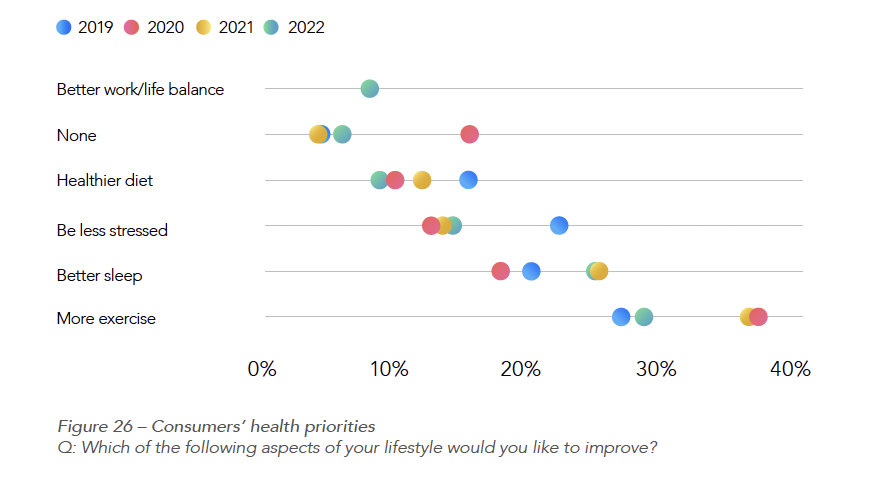Health comes first for consumers

ReMark's 2022-23 Global Consumer Study examined people's physical health. After a small dip last year, exercise levels have bounced back to above pre-pandemic levels. It may be too early to say that exercise habits gained during the pandemic are now permanent, but it is encouraging to see more people being active.
-
54.4% exercise for more than 20 minutes, 3+ times a week
Nearly two-thirds of respondents (61.4%) say that healthy living plays a large or very large role in their lifestyle. This is marginally lower than last year’s recorded figure of 63.8% (Figure 23). There are, however, significant differences in lifestyle claims between the respondents of different markets. The most health conscious are those from Chile, China, Mexico and Spain where over 80.0% of respondents claimed that healthy living played an important role in their daily life. The most apathetic are in Ireland, Italy, Japan and UK where less than 50.0% made similar claims. The Japanese were especially indifferent to the merits of a healthy lifestyle with only 30.0% acknowledging its importance to the way they live. However, this does seem at odds with the fact that, as a general observation, Japan is a country noted for its healthy diet and the longevity of its population.

We explored these claims in greater detail through questions about diet, exercise, smoking habits and mental health.
Being physically active is one of the key elements of a healthy lifestyle. It is one of the most effective ways to control weight and to combat serious conditions such as heart disease, diabetes and even depression.

It is a message that appears to be well understood. More than half (54.4%) of this year’s respondents say they exercise for at least 20 minutes more than three times a week. This is an encouraging return to a positive trend that we had observed before a setback last year as a result of the pandemic (Figure 24). Most generations showed an increase in activity compared with two years ago. The exceptions to the rule are the Boomers and the Silent Generation. This is perhaps to be expected as increasing age takes its toll on the physical abilities of these cohorts.
At first sight there is, surprisingly, little difference in the exercise habits reported by people who might be expected to have very different levels of fitness. In Figure 25, we group responses according to the body mass index of the respondents, and we see that the proportion of those who are overweight or obese and who claim to exercise more than three times a week (over 50.0% for both groups) is not markedly different from that of the healthy weight group (57.0%).

It is at the other end of the scale that the differences become more apparent with 27.4% of the obese rarely or never exercising, compared with 18.6% of the healthy weight group.
Health improvements
Recognition of the value of exercise to improve health is further evidenced by the responses to a question that asked respondents to rank aspects of their lifestyle that they would like to improve. Doing more exercise was ranked the first priority by 29.1% of respondents.
By comparison, fewer than 10.0% of respondents nominated an improvement in diet as their main priority. Those whose body mass index suggested that they are overweight or obese put exercise ahead of diet as a means to improve health (Figure 26).

We get a clue as to why respondents attach relatively little importance to improvement in diet from responses to a question that asked the survey participants about their eating habits. 62.8% of respondents claim that they already eat healthy food either all or most of the time. 56% of the obese group claim to have a reasonably healthy diet. (Figure 27).
| Underweight | Healthy Weight | Overweight | Obese | BMI unknown | |
| I always eat healthy food | 21.6% | 18% | 12.7% | 14.2% | 13.5% |
| I try to eat healthily most of the time | 41.7% | 51.5% | 50.9% | 41.8% | 42.3% |
| I eat healthy some of the time | 26.6% | 23.9% | 28.1% | 34.3% | 30.7% |
| I rarely eat healthy food | 3.7% | 2.5% | 3.3% | 2.7% | 5.5% |
| I don't care | 3.7% | 2.5% | 3.3% | 2.7% | 5.5% |
| Grand Total | 100% | 100% | 100% | 100% | 100% |
Figure 27 – Breakdown of consumers’ eating habits according to their BMI / Q: How would you rate your diet?
By far the healthiest eaters are the Silent Generation, 78.3% of whom have, or claim to have, a mostly healthy diet. It is perhaps a generation that is less wedded to fast food. However, it is Millennials who have the greatest proportion (18.7%) who claim that they always eat healthy food (Figure 28).

Smoking and health
It is nearly 50 years since Doll & Peto[1] published their paper that gave conclusive evidence of the link between smoking and disease. Since then, many governments have adopted policies to discourage the promotion and sale of cigarettes and to limit their use in public spaces. Despite the barriers and all the evidence, it has proved to be a hard habit to break – and a hard habit to stop people taking up.
A surprising 22.0% of our respondents reported that they had smoked within the last 12 months. What is yet more surprising is that this includes 23.9% of Millennials and 18.1% of Gen Z, people born after the harmful effects of smoking had become well established. Conversely, amongst the Silent Generation only 10.0% are current smokers (Figure 29).
| Never smoked | Have not smoked in the past 12 months | Have smoked in the past 12 months | Smoke electronic cigarettes | Prefer not to say | |
| Gen Z | 60% | 12% | 18.1% | 7% | 2.9% |
| Millennials | 53.9% | 11.7% | 23.9% | 7.8% | 2.7% |
| Gen X | 54% | 13.6% | 24.8% | 5% | 2.7% |
| Boomers | 51.4% | 24.3% | 20.3% | 2.2% | 1.8% |
| Silent Gen | 45.3% | 40.2% | 10.4% | 0.6% | 3.6% |
| Global Average | 54.3% | 15.4% | 22.1% | 5.6% | 2.6% |
Figure 29 – Smoking status per generation / Q: Are you a smoker?
References
[1] Doll R., Peto R. (1976) Mortality in relation to smoking: 20 years' observations on male British doctors. British Medical Journal. 1976 Dec 25;2(6051):1525-36.